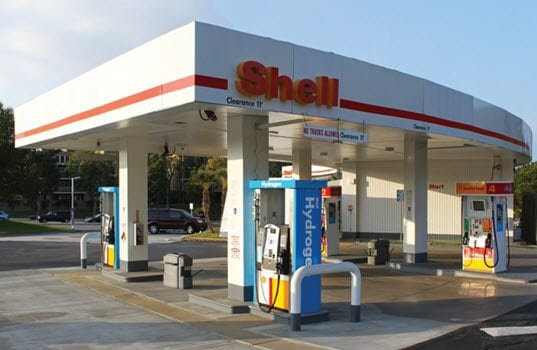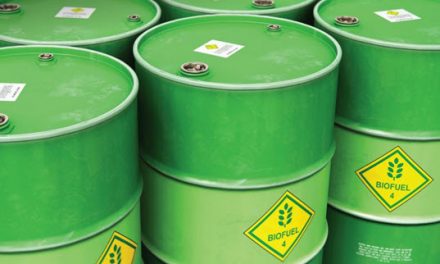Gaseous hydrogen can be delivered in tube trailers to the retail fueling location and stored on site. This method allows for a smaller total footprint and flexible placement but may have limited storage capacity.
Liquid hydrogen can also be delivered and stored to a retail location. This method provides greater storage capacity but also includes a larger equipment footprint.
Electrolysis of water on site to produce hydrogen is another potential hydrogen source. This method requires a water purifier and therefore can be more expensive than other methods. But electrolysis also allows for the generation of carbon credits and meets state renewable energy requirements.
Steam methane reformation (SMR) of natural gas allows hydrogen production from existing natural gas supply lines. This method allows for onsite fuel production and provides a larger capacity but also may be a bit more expensive than other methods of hydrogen storage and production.
In those instances where retail fueling stations are located near existing hydrogen pipelines used for industrial purposes, hydrogen fuel can be drawn from these larger pipelines and purified to provide hydrogen fuel for FCEVs. This hydrogen production method however requires purification equipment requiring a larger footprint.
In the near term, gaseous and liquid hydrogen delivery and storage are expected to be the predominant hydrogen storage methods being pursued by station developers.
Hydrogen Fueling Station Costs
The nine public hydrogen stations in California are essentially demonstration stations in which different combinations of technologies are implemented to demonstrate their feasibility. As the stations are each unique, the costs therefore do not reflect commercial station pricing. On average, the public hydrogen stations in California have averaged around $2 million each to build. The next round of stations being developed in California will be one step closer to a more uniform, commercial type of fueling station design.
Going forward, as with other new technologies, we can expect the cost of stations to decrease as the volume of stations produced increases and economies of scale are leveraged. The current round of grant funding for hydrogen stations in California provides up to 85% of the cost of a station or $2.125 million, whichever is less.
The Cost of Hydrogen Fuel
Currently, the costs of fueling hydrogen vehicles are incorporated into fueling contracts between the hydrogen fuel providers and the auto manufacturers. Vehicle operators do not pay for hydrogen fuel at the pump when they fill up their FCEVs. The California Division of Measurement Standards is currently type certifying the existing public hydrogen fueling station dispensers to officially allow the direct sale of hydrogen fuel to consumers.
When consumers begin paying for hydrogen fuel at the pump, the expectation is that the cost to fill up their FCEV will be comparable to the cost of filling up their current gasoline vehicle.
Just the Beginning
Considerable progress towards the commercialization of fuel cell vehicles has been achieved in the last year. In addition, a number of automotive strategic partnerships were formed in 2013 to jointly develop hydrogen fuel cell technology. These include Toyota and BMW; Daimler, Ford and Nissan; and Honda and GM. Hyundai announced its 2014 Tucson Fuel Cell vehicle launch in California in Spring 2014. And Toyota and Honda unveiled their production and concept fuel cell electric vehicles for introduction in 2015.
California announced on May 1 $46.6 million in proposed awards for 28 new hydrogen fueling stations, expanding the state’s network to over 50 stations by November 2015. Fifteen new hydrogen filling stations are scheduled to become operational in California by December 2014. Kalibrate (formerly KSS Fuels) will be conducting a DOE funded study of retail hydrogen fueling stations in California which is expected to be completed in December of 2014. Toyota and Honda will be introducing their next generation commercial FCEVs to the market in 2015. And Mercedes and Nissan will be introducing their next generation FCEVs in 2017.
Beyond California at the national level, a new public-private initiative, H2USA, was launched by the Department of Energy in May of 2013. Through section 177 of the Clean Air Act, other states can adopt California’s car emission standards. Currently, nine other states have adopted California’s ZEV program to help achieve their quality goals. The states include New York, Massachusetts, Maine, Rhode Island, Connecticut, Vermont, New Jersey, Maryland and Oregon. H2 USA will be focusing on the issues associated with future introduction of hydrogen fuel cell vehicles in these states.
Fuel cell electric vehicles are ready for their commercial launch. To support their launch, retail-focused hydrogen infrastructure is being developed throughout California, presenting business opportunities for both fuel retailers and fuel marketers doing business in the state. And beyond California, H2USA will be focusing on a national launch of hydrogen fuel cell vehicles in the near future. Stay tuned.
 Joe Gagliano is an Infrastructure Business Development Specialist at the California Fuel Cell Partnership (CaFCP). He has over 20 years of experience managing clean technology programs and projects in the government, private and non-profit sectors. His focus at the Partnership is working with energy, automotive and technology companies to develop and expand hydrogen fueling infrastructure throughout California. He has extensive experience as a consultant and government program manager in the clean technology sector, and has been involved in shaping environmental and energy technology policy at the state, regional and national levels. Gagliano formerly served as Manager of International Business Development for DMJM International, an engineering services firm in Los Angeles, and Director of Calstart’s Pasadena clean technology business incubator. Prior to Calstart, Gagliano was a Senior Associate with the environmental and energy consulting firm M. J. Bradley & Associates and was also program manager for New York State’s LEV/ZEV program. He holds an M.A. in Public Policy from the State University of New York at Albany and a Bachelor’s degree in Electrical Engineering from Union College (NY).
Joe Gagliano is an Infrastructure Business Development Specialist at the California Fuel Cell Partnership (CaFCP). He has over 20 years of experience managing clean technology programs and projects in the government, private and non-profit sectors. His focus at the Partnership is working with energy, automotive and technology companies to develop and expand hydrogen fueling infrastructure throughout California. He has extensive experience as a consultant and government program manager in the clean technology sector, and has been involved in shaping environmental and energy technology policy at the state, regional and national levels. Gagliano formerly served as Manager of International Business Development for DMJM International, an engineering services firm in Los Angeles, and Director of Calstart’s Pasadena clean technology business incubator. Prior to Calstart, Gagliano was a Senior Associate with the environmental and energy consulting firm M. J. Bradley & Associates and was also program manager for New York State’s LEV/ZEV program. He holds an M.A. in Public Policy from the State University of New York at Albany and a Bachelor’s degree in Electrical Engineering from Union College (NY).









